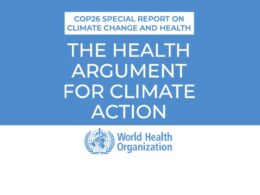But it did agree a mechanism to fill it in
The Economist
November 20th, 2021
AS COP26 FINALLY came to a close on November 13th, more than 24 hours behind schedule, the mood inside the drab temporary buildings erected to house it on the banks of the River Clyde was a mix of celebration and frustration.
The painful reality suffusing the conference was that the world is failing to limit global warming to 1.5°C above pre-industrial levels, despite promising to do so in the Paris agreement of 2015.
Yet the summit put a series of new procedures in place that keep alive the possibility of reaching that goal, if countries suddenly find it within themselves to embrace drastic measures.
In an admission that the goals set in Paris were not being met, the summit sought to speed up the fight against climate change in a number of ways. There was an unexpected, and eventually unanimous, call for a faster phasing down (though not out) of the “unabated” (ie, polluting) use of coal and for the scrapping of subsidies for fossil fuels. In a departure from previous COP s, a number of countries joined assorted “coalitions of the willing” to do their part to eliminate coal power, reduce methane emissions, make financial services greener, protect forests and more.
Perhaps most important of all, governments agreed to beef up their national plans for reducing emissions over the coming decade before meeting for next November’s COP 27 in the Egyptian resort of Sharm el-Sheikh. That means translating the promises made in Glasgow into policies and seeking new ways to hasten the transition away from fossil fuels by 2030.
One way to look at the 1.5°C challenge is in temperature terms. The global average in 2020 was 1.1–1.3°C warmer than pre-industrial levels, and that figure is rising by 0.1–0.3°C each decade. The pledges made at the time of the Paris agreement in 2015 led climate modellers to project a “best guess” of 2.7°C of warming by 2100. The more ambitious ones made in Glasgow reduced that by perhaps 0.3°C.
Another way of measuring the task ahead is in billions of tonnes of avoided greenhouse-gas emissions. Prior to Glasgow, there was a gap of 23bn-27bn tonnes between the emissions reductions needed by 2030 to avoid more than 1.5°C of eventual warming and the emissions foreseen between now and 2030 in countries’ climate pledges, known as nationally determined contributions or NDCs. The new NDCs for 2030 presented in the run-up to the summit narrowed the gap by a mere 4bn tonnes, according to Climate Action Tracker ( CAT), a coalition of climate modellers. Pledges at the summit on methane, coal, electric vehicles and forestry shaved off roughly 2bn tonnes more. So, on top of current commitments, further cuts of approximately 17bn-20bn tonnes of greenhouse gases must be made before 2030 to meet the 1.5°C goal (see chart).

The past year has seen many countries promise to achieve net-zero emissions by mid-century. The next must focus on curtailing emissions in the coming decade. The 17bn-20bn tonnes of greenhouse gases that need to be cut by 2030 correspond to a 45% drop from 2010 levels. Even then, there would be only a 50% chance of limiting global warming to 1.5°C, says the Intergovernmental Panel on Climate Change, a UN-convened conclave of climate scientists. Yet current NDC s will result in a rise in emissions, not a drop, by 2030.
The yawning gap between ambition and reality, and the dwindling time to close it, are what drove attention in Glasgow to the Paris agreement’s “ratchet”: a clause stating that every five years parties to the agreement must lay out their plans for reducing emissions by the end of the subsequent decade. Glasgow in effect added an extra crank of the ratchet by requesting fresh pledges for 2030 be made by November next year, before decarbonisation plans for 2035 are presented in 2025.
Even these extra pledges are unlikely to be sufficient to limit global warming to 1.5°C. But the widespread view in Glasgow was that, even though the necessary cuts would be almost impossible or cripplingly expensive to meet, the 1.5°C goal should not be abandoned because each step towards it is beneficial. Every tenth of a degree of warming has consequences for human wellbeing and carries large financial costs. Extreme weather brought about by global warming has proliferated over the past decade. Counterfactual climate modelling has shown it contributing to all manner of calamities from fires to floods and deadly heatwaves.
Show me the money
Another focus in Glasgow was the need for more lending to help poor countries shift out of fossil energy, to build societies that are better adapted to the impacts of climate change, and to recover from the damage caused by extreme-weather events.
Poor countries resent that they were promised $100bn annually by 2020 to deal with the first two needs, yet only $80bn a year has materialised.
Eventual costs are likely to be in the trillions. Yet the only material concession that was made related to funding for adaptation, which was supposed to have made up half of the $100bn but so far has only amounted to some $20bn.
Rich countries pledged in Glasgow to at least double the amount given by 2025.
The talks were marked by a perceptible change in the rhetoric around such financial assistance. In the 2010s, poor countries framed the $100bn figure partly as a show of solidarity from rich countries and partly as a charitable grant. The West had grown wealthy by burning fossil fuels, the argument ran, and so should help clean up the mess. In addition to this moral claim to assistance, another justification came to the fore in Glasgow. It frames the cash as an essential tool for energy transition, rather than as a form of aid. Without it, poor countries said they could not decarbonise, thus jeopardising the Paris goals-so more cash will need to be found.
One model for doing this will be closely watched over the coming year. America, Britain, the EU, France and Germany have agreed to raise a pot of $8.5bn from a mix of public and private sources for South Africa. In exchange it has agreed to decarbonise its electricity supply, currently derived almost entirely from coal, while protecting the livelihoods of the 120,000 people who work in the industry. If the results between now and COP 27 are promising, it could become a model for other countries.
A host of other measures, taken together, could begin to narrow the emissions gap. More countries could sign up to the “sectoral pledges”, as the coalitions of the willing are known in climate jargon, or to adopt their own goals if, like China, they are reluctant to join the multilateral deals. As part of its renewed climate collaboration with America announced in Glasgow, China said it would draw up a national strategy for curbing methane emissions. That is important, since it spews out more of the stuff than any other country, and did not sign up to the sectoral pledge. John Kerry, America’s COP26 envoy, suggested the Chinese plan on methane would be unveiled before COP 27.
CAT estimates that if all countries were to sign on to all four sectoral pledges on methane, coal, cars and forests, the 17bn-20bn tonnes in emissions cuts needed to reach 1.5°C could be narrowed by a further 6bn-9bn tonnes. That is large but hypothetical since the forest pledge, especially, is questionable, given the failure of previous efforts to curb deforestation and the fact that Indonesia, one of the worst culprits, has already withdrawn support.
Voluntary carbon markets could also contribute to emissions reductions, but only if their standards are improved. Although the volumes traded are not yet in the billions of tonnes, demand has grown and is receiving a boost from the increasing number of private companies with climate targets. Theoretically, these markets could help steer private funds towards the most effective carbon-reducing projects and accelerate decarbonisation. But the markets are poorly regulated and standards are variable.
Other avenues to narrow the emissions gap to 1.5°C include financial incentives for emerging economies to cut emissions with a mix of public and private funds, the threat of carbon border-adjustment mechanisms that will tax CO 2-heavy imports, and more transparency and accountability in the private sector. Currently, there are hundreds of different standards for corporate disclosure of environmental, social and governance ( ESG) data. Firms can therefore cherry-pick flattering numbers and investors struggle to compare different companies.
Regulators can also play a part in corporate transparency. António Guterres, the secretary-general of the UN, intends to set up a body to examine net-zero pledges made by companies and to develop standards. Rishi Sunak, Britain’s chancellor, said that the country will “strengthen requirements’’ from 2023-but not yet make it mandatory-for all British financial institutions and all companies listed on British stockmarkets to publish plans explaining how they will decarbonise operations, lending and investment. However, all these regulatory measures will take years to have much effect.
The next 12 months will be marked by a constant drumbeat to keep up the pressure on climate change. In April the 15th UN biodiversity summit will release new goals for protecting ecosystems. Some of these will seek to fight climate change as well by increasing the volumes of CO 2 that are soaked up by vegetation and the oceans. In June the Swedish government will host a UN conference to mark the 50th anniversary of the first Earth summit. Throughout the year, a UN-sanctioned global stock-taking of progress towards the Paris agreement goals will get under way. Its conclusions are due in 2023.
And the Intergovernmental Panel on Climate Change will publish not one but three reports, the first of which will almost certainly conclude that the impacts of climate change are already at the high end of what previous reports had anticipated, and that future effects, even if warming could be limited to 1.5°C, are likely to be worse than previously thought in rich and poor countries alike.
That will also be a focus of the new COP presidency. The handover began in Glasgow, where Egyptian leaders hinted that adaptation and resilience would be high on the agenda for COP 27. Sharm el-Sheikh, too, is likely to see frustration do battle with celebration. ■
For the latest from COP26 see our news updates. For more coverage of climate change, register for The Climate Issue, our fortnightly newsletter, or visit our climate-change hub
This article appeared in the International section of the print edition under the headline “Out of reach?”
Originally published at https://www.economist.com on November 20, 2021.












